Standard pillow sizes
Although we'll be covering all the pillow types, it only makes sense to start things off with the standard pillow. After all, it's what most people will end up using and is the one that has the most variety. So, we'll break it down by age range and discuss the pillow dimensions that are best suited for each scenario.
Baby pillows
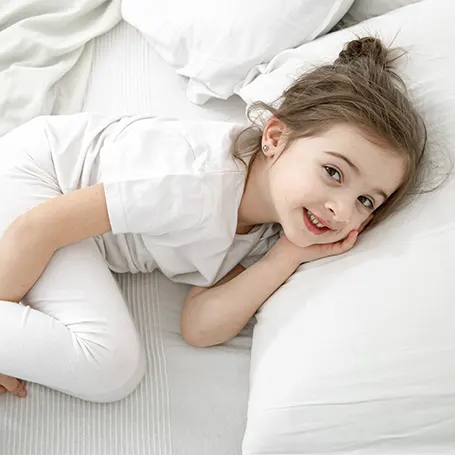
Getting a good sleeping pillow for a baby can be arguably very tricky, as it has the slimmest margin for error. After all, while babies are still developing, it's essential to get a pillow that properly supports their head and neck.
And, as you would've probably guessed, we'd need the pillow size to be on the smaller side. Let's take Panda's Baby Bamboo Pillow as an example. As you can see, it's only 45 x 25 cm big, making it roughly the size of a travel pillow. And this is important for a few reasons.
Firstly, since a baby is unlikely to sleep in a twin bed, we want to make sure that the pillow doesn't have to be squeezed into the crib. This can make it bulge out in the middle and create an uneven surface. Secondly, it's a lot more practical if you have to get out of the house and you're dealing with a continuous napper!
But the most important dimension is the depth. Once again looking at Panda's Baby Bamboo Pillow, we can see that it's only 3 cm deep. And it's this measurement that will keep your baby safe, as you want a pillow that's roughly the size of your baby's shoulder. This is because anything larger, like a queen pillow, is going to put a lot of strain on your baby's neck and potentially cause neck pain.
Toddler pillows
When it comes to toddler pillows, they need to be slightly larger on all fronts. The width and heights for toddler pillows are usually around 50 x 40 cm to more easily accommodate the slightly larger head size. And the depth is also slightly larger at around 6 cm.
However, the pillow size depends heavily on how quickly your child grows. So, if you see that your child's shoulders are wider or narrower than 6 cm, make the appropriate adjustments. However, it's still advised to stay away from king pillows or anything else of that size.
Kids pillows
When it comes to kids pillows, the size tends to vary the most. After all, while even ages 4-8 tend to have a lot of growth spurts, things can get a lot more dramatic after 8-10. So, when it comes to the latter part of that range, it's difficult to pick out a single pillow size that would suit most children.
We'd say to just go with standard, square pillows and make adjustments to the height of the pillow depending on how quickly the child grows. You could potentially opt for a king or a queen-size pillow after age ten if your child has broad shoulders but that varies from case to case.
When it comes to ages 4-8, a pillow that's about 10 cm tall will usually be the appropriate size. And when it comes to the heights and width, it's mostly open-ended. That being said, we will discuss some caveats a bit later on.
Body pillows
Unlike standard square pillows, the proper size of a body pillow is a lot harder to gauge. This is because they can vary in shape quite significantly. Plus, it's not as intuitive to get the right pillow as there's more to consider than just the pillow loft. So, let's talk about each body pillow type individually, see what they're good for, and whether there's anything you need to take special note of.
Rectangular body pillows
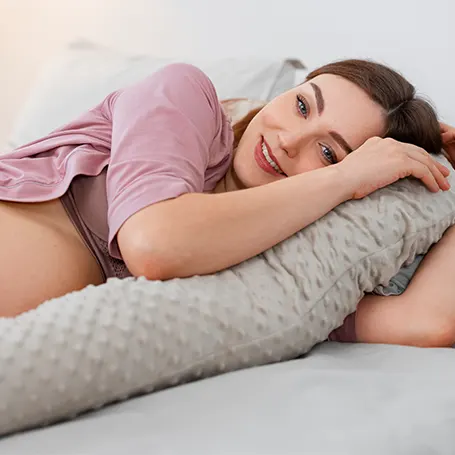
Among body pillows, rectangular (or standard) body pillows are probably the easiest ones to get right. This is because these pillows go “in a straight line” and are usually used as the target for overnight hugs. Therefore, all you have to worry about is if the pillow is too short, your child might be displeased.
And, if you want to play it extremely safe, see whether your child also likes to wrap their legs around the pillow. If so, try to avoid extra thick pillows as they could be bad for their joints. But as long as it's a thinner pillow that isn't too short, you should be fine. Although we do encourage looking for an especially cute design if you really want to surprise your kids!
Lastly, everything we've said so far hinges on the fact that the child is using the body pillow as a supplementary hugging pillow. If it's their main pillow, make sure that the pillow loft isn't too high, as discussed in the first section.
Curved body pillows
When we say curved body pillows, we mean C-shape, U-shape, and J-shape pillows in particular. Of course, this is because all three have very distinct curves that typically wrap around your body to some extent.
For this reason, they're a bit trickier than regular rectangular body pillows. First off, curved body pillows are made so that you can wrap your legs around them. So, taking note of the pillow thickness is important. However, even more important is the length of the pillow.
After all, curved pillows typically support your head and your feet at the same time. So, making sure that they can accomplish both without the child needing to be in an awkward position is key. As a general rule of thumb, a curved pillow should be approximately the same length as the distance between your child's head and pelvis.
That being said, since they can vary in angle and sometimes feature more unique shapes and designs, it's difficult to find a one-size-fits-all solution. So, if possible, try out a few different pillows.
V-shaped body pillows
We've decided to give V-shaped pillows a separate spot as their function is slightly different from the previous two categories. While you can use them to support your head and neck, V-shaped pillows are particularly useful to put between your knees.
And since it's a knee pillow, the pillow size isn't as precise. As long as the pillow loft isn't too big, the pillow should suffice. That being said, V-shaped pillows are usually either used by adults or by parents to gently cradle their baby in their lap. So, if you want to get a V-shaped pillow for your child, know that they'll usually be in adult sizes.
Orthopaedic pillows
If the reason you're reading this article is because your child already has neck/spine issues, an orthopaedic pillow could be the way to go. After all, they're speciality pillows that cradle your head and allow your spine to be in a healthy position. That being said, since it's less popular than traditional pillows, you're not likely to see the same degree of variety.
That being said, it's not impossible to find orthopaedic pillows that are designed for children and thus have a much lower loft. On top of that, they usually utilise memory foam, which is a big plus. This is because a memory foam pillow has a lot more give and can therefore be corrected to an extent.
Just like all the pillows before, there are subtypes as well. Namely cervical and contour pillows. However, the same logic applies to both, so, just take note of the loft.
When should you get a bigger pillow?

As you can see, pillow sizes can vary quite heavily depending on the age of your kids. So, it's only reasonable to wonder when exactly should you swap them out. However, the answer isn't that simple.
For example, it depends on the sleep style of your child. If they're back sleepers, then their perfect pillow won't change too much over the years. As long as it's comfortable and their spine is in a straight line, all is good. And a similar principle applies to front sleepers, as you'll always want a thin pillow, regardless of age.
However, most people are side sleepers and that's where it gets a bit complicated. For one, it heavily depends on how quickly your child grows and how wide their shoulders are. So, while some ten-year-olds could make use of a king pillow, others might want to stick to a kids pillow for a few more years.
On top of that, the loft of the pillow isn't standardised like the height and width. So, a king-size pillow from one brand can have a smaller loft than a queen pillow from a different brand. Therefore, we can't just say queen pillows are ideal for this age or king pillows are ideal for that age.
But we do advise keeping track of how your child grows and upgrading their pillow size when you see that they've outgrown their current one. For early childhood, brands like Panda are especially useful since they offer baby, toddler, and kids pillows all in one place. You can check out Panda's entire kids catalogue right here! And even if you don't want your pillow to grow up alongside your child, make sure you know when pillows should be swapped out in general. After all, they don't last forever.
Which material should the child's pillow be made from?
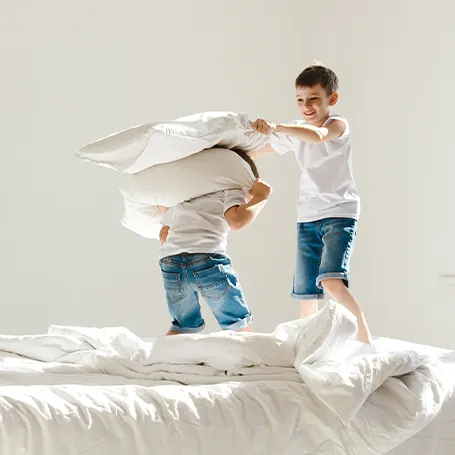
Something that we haven't mentioned so far is that the material of the pillow can also influence which pillow size you want. And this is mostly due to the fact that different pillow materials compress in slightly different ways.
For example, a King pillow that's made from feathers and down will likely flatten down to about a quarter of its original loft once pressure is applied. However, that's not a good thing, as the sides will stay up and can become a potential choking hazard.
Memory foam on the other hand won't compress as much but will give you some leeway. And a firmer pillow, made from microfibre for example, will hardly lose any loft at all during the night. So, keep in mind that just because the product description states a certain loft doesn't mean it will be that exact size in practice.
Which pillow materials are the best for children?
And while we're on the topic of materials, some are also a lot better than others in terms of comfort and safety. For example, regardless of the pillow size, you want to find a pillow that hasn't been treated by any dangerous chemicals. So, a pillow with an OEKO-Tex certification.
Secondly, you'd want a pillow that's good for the child's skin. So, a pillow that's hypoallergenic and breathable. This is so that you minimise any potential skin rashes or other similar issues. In this category, things like bamboo or eucalyptus are usually safe bets.
What size should the child's bed be?

With all of this talk of pillow sizes, it only makes sense to briefly mention their actual beds as well. For most people, the transition from a cot to a bed is standard practice. However, should they start out in a twin bed or should they immediately have a queen bed?
Luckily, things aren't as serious in this department. While king-size pillows can strain your child's neck if they're too small, a king-size bed can't really do any harm. The only suggestion we have is to take note of whether your child has any nighttime disturbances. For example, if they roll out of bed frequently, look into getting a bigger bed or a mattress with good edge support.
Conclusion
Overall, getting the correct pillow size can be a bit tricky. However, if you know what to look out for, it shouldn't be too difficult. Just make sure that your child's neck and spine are always in a healthy position and opt for higher-quality materials if you can.
We also suggest swapping out the pillows as the child ages in order to make sure they always have the most optimal loft and size. However, as you've seen by now, it heavily depends on how quickly your child grows, how they sleep, and which pillow they're using. And if you have any questions or recommendations about pillow sizes for children, let us know down in the comments.


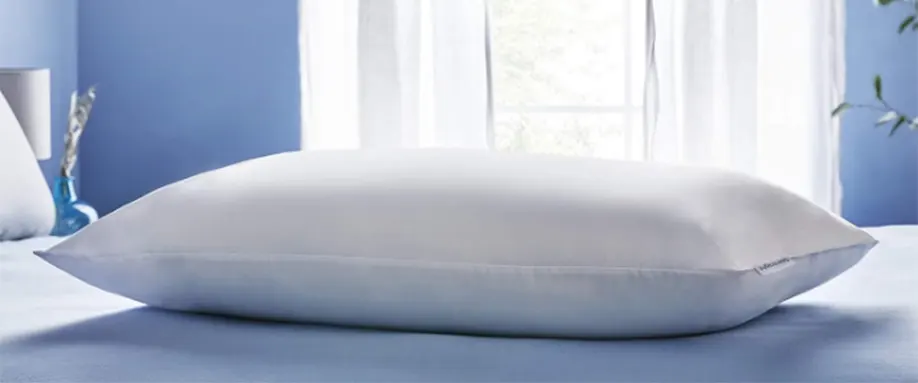
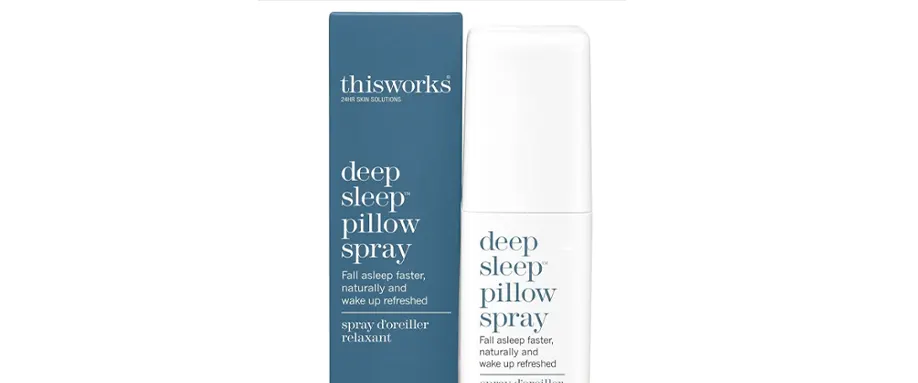











There are no comments yet
"*" indicates required fields